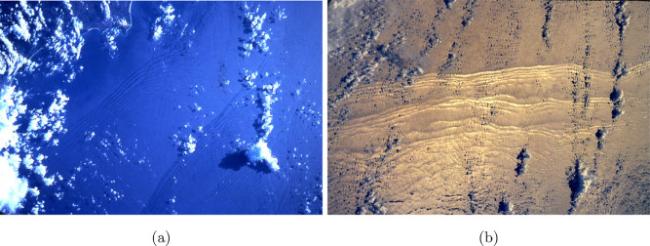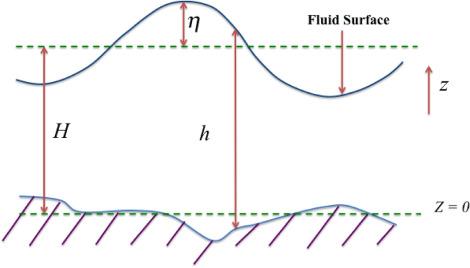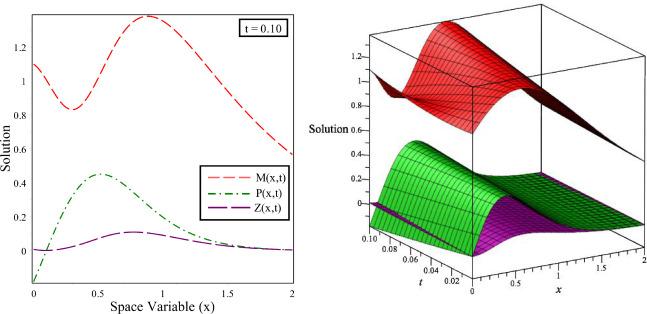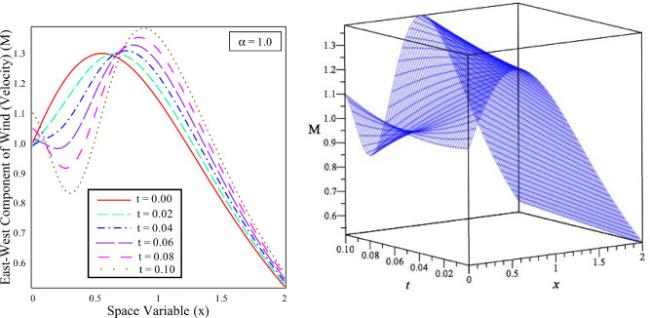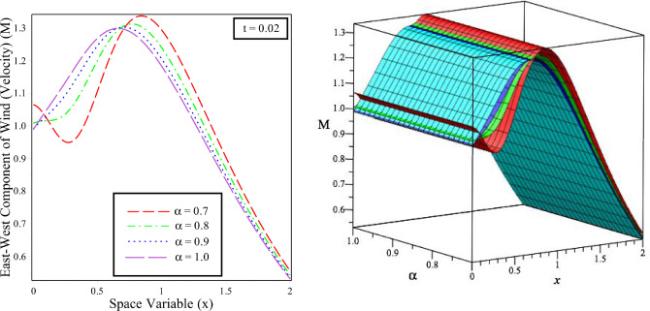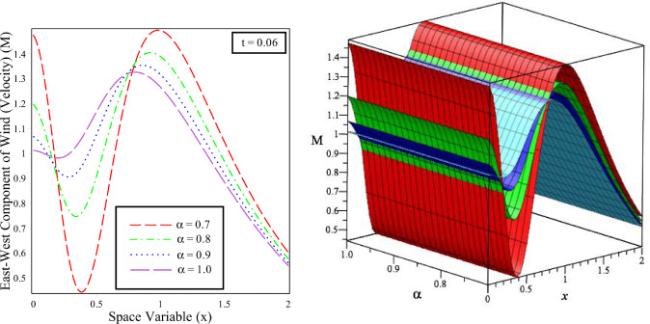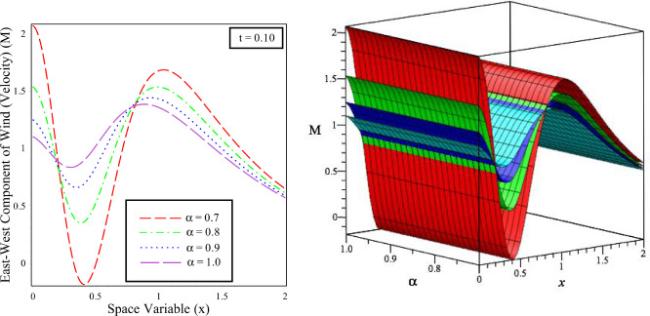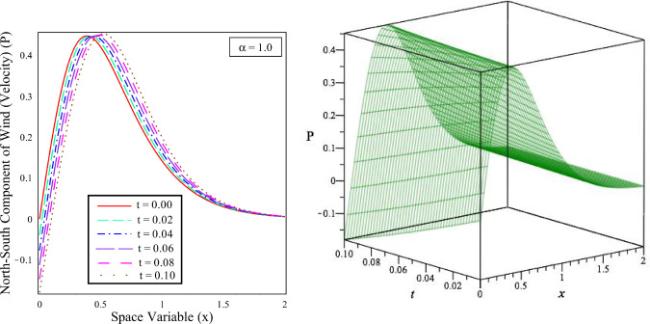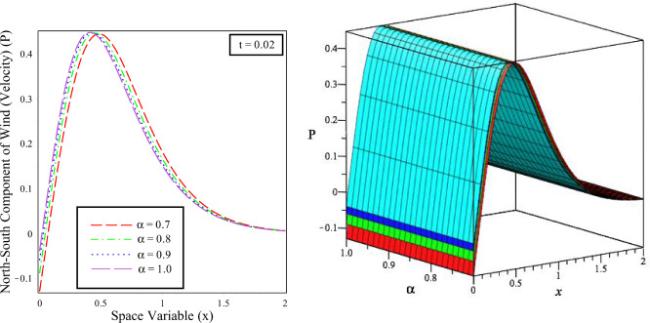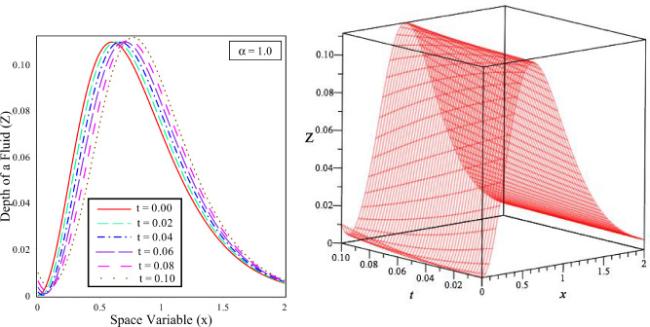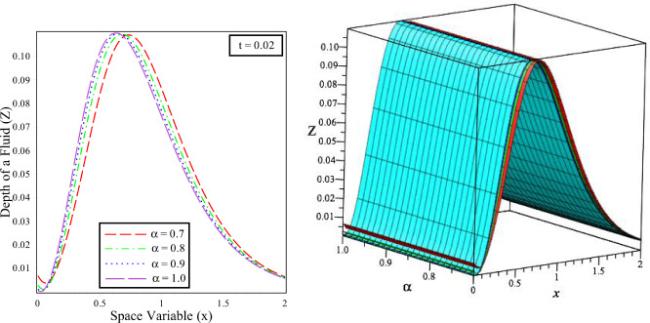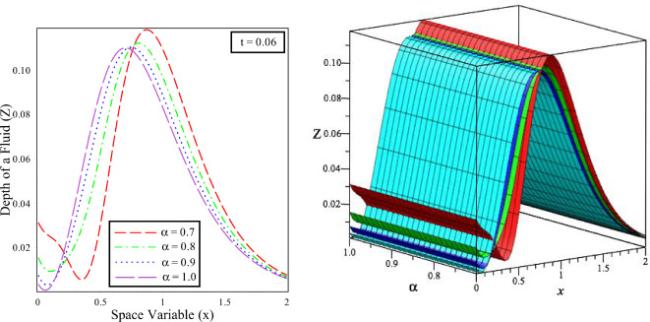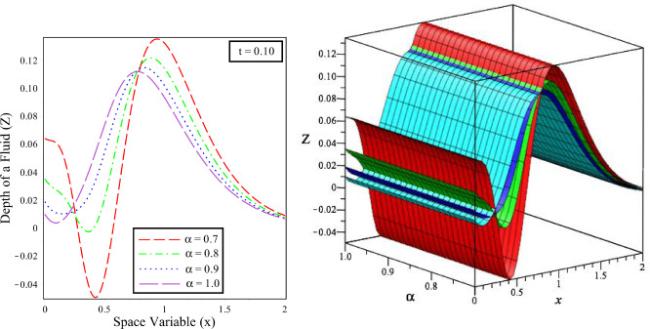1. Introduction
Fig.1 Internal waves in (a) south china sea (STS-7, June 1983, picture-#7-05-0245) and (b) Eastern Pacific Sea (STS-41C, April 1984, picture-#13-31-980). |
Fig.2 Schematic representation of internal waves. |
2. Mathematical model formulation
3. Formulation of fractional reduced differential transform method
Let us assume is analytic function and continuously differentiable w.r.t and in the domain of choice. The reduced differential transform of is defined in Tandel et al. [15], Patel and Patel [20] is as follows:
where represents the time-fractional order derivative, represent operator of the reduced differential transform.
Definition 3.2
The inverse differential transform of defined as follows:
where represent operator of the inverse reduced differential transform.
By inserting Eqs. (20) in (21), we obtain
4. Application of FRDTM
5. Results and discussion
Fig.3 The solution behaviour of , , and versus distance in 2D and 3D for fixed time and integer order . |
Fig.4 The solution behaviour of East-West Component of wind (velocity) ()) versus distance in 2D and 3D for different time . |
Fig.5 The solution behaviour of East-West Component of wind (velocity) ()) versus distance in 2D and 3D for fixed time different fractional order values and integer order . |
Fig.6 The solution behaviour of East-West Component of wind (velocity) ()) versus distance in 2D and 3D for fixed time different fractional order values and integer order . |
Fig.7 The solution behaviour of East-West Component of wind (velocity) ()) versus distance in 2D and 3D for fixed time different fractional order values and integer order . |
Fig.8 The solution behaviour of North-South Component of wind (velocity) () versus distance in 2D and 3D for different time. |
Fig.9 The solution behaviour of North-South Component of wind (velocity) () versus distance in 2D and 3D for fixed time different fractional order values and integer order . |
Fig.10 The solution behaviour of North-South Component of wind (velocity) () versus distance in 2D and 3D for fixed time different fractional order values and integer order . |
Fig.11 The solution behaviour of North-South Component of wind (velocity) () versus distance in 2D and 3D for fixed time different fractional order values and integer order . |
Fig.12 The solution behaviour of depth of fluid versus () distance () in 2D and 3D for different time . |
Fig.13 The solution behaviour of depth of fluid versus () distance () in 2D and 3D for fixed time different fractional order values and integer order . |
Fig.14 The solution behaviour of depth of fluid () versus distance () in 2D and 3D for fixed time different fractional order values and integer order . |
Fig.15 The solution behaviour of depth of fluid () versus distance () in 2D and 3D for fixed time different fractional order values and integer order . |
Table 1 Numerical comparison of for different spaces and times. |
| x | t=0 | t=0.02 | t=0.04 | |||||||||
| Empty Cell | FRDTM | EADM [10] | HAM [8] | NUM | FRDTM | EADM [10] | HAM [8] | NUM | FRDTM | EADM [10] | HAM [8] | NUM |
| 0.0 | 1.00000 | 1.00000 | 1.00000 | 1.00000 | 0.98766 | 0.98000 | 0.98350 | 0.97226 | 0.98911 | 0.96000 | 0.96700 | 0.98792 |
| 0.2 | 1.17382 | 1.17382 | 1.17382 | 1.17382 | 1.10403 | 1.10026 | 1.11313 | 1.10934 | 1.04412 | 1.02669 | 1.05244 | 1.05275 |
| 0.4 | 1.27646 | 1.27646 | 1.27646 | 1.27646 | 1.22231 | 1.22755 | 1.23611 | 1.21777 | 1.15984 | 1.17863 | 1.19575 | 1.15837 |
| 0.6 | 1.29658 | 1.29658 | 1.29658 | 1.29658 | 1.29335 | 1.29910 | 1.29866 | 1.28681 | 1.27748 | 1.30162 | 1.30074 | 1.27049 |
| 0.8 | 1.24420 | 1.24420 | 1.24420 | 1.24420 | 1.27483 | 1.27677 | 1.27107 | 1.27570 | 1.30042 | 1.30933 | 1.29793 | 1.29907 |
| 1.0 | 1.14161 | 1.14161 | 1.14161 | 1.14161 | 1.18152 | 1.18095 | 1.17406 | 1.18742 | 1.22226 | 1.22029 | 1.20652 | 1.22837 |
| 1.2 | 1.01270 | 1.01270 | 1.01270 | 1.01270 | 1.04835 | 1.04712 | 1.04110 | 1.05252 | 1.08655 | 1.08154 | 1.06949 | 1.09214 |
| 1.4 | 0.87654 | 0.87654 | 0.87654 | 0.87654 | 0.90377 | 0.90272 | 0.89814 | 0.90394 | 0.93323 | 0.92890 | 0.91974 | 0.93390 |
| 1.6 | 0.74557 | 0.74557 | 0.74557 | 0.74557 | 0.76473 | 0.76404 | 0.76081 | 0.76325 | 0.78537 | 0.78251 | 0.77604 | 0.78358 |
| 1.8 | 0.62649 | 0.62649 | 0.62649 | 0.62649 | 0.63937 | 0.63897 | 0.63678 | 0.63835 | 0.65310 | 0.65144 | 0.64707 | 0.65179 |
| 2.0 | 0.52204 | 0.52204 | 0.52204 | 0.52204 | 0.53047 | 0.53025 | 0.52882 | 0.53005 | 0.53936 | 0.53846 | 0.53559 | 0.53882 |
Table 2 Numerical comparison of for different spaces and times. |
| x | t=0 | t=0.02 | t=0.04 | |||||||||
| Empty Cell | FRDTM | EADM [10] | HAM [8] | NUM | FRDTM | EADM [10] | HAM [8] | NUM | FRDTM | EADM [10] | HAM [8] | NUM |
| 0.0 | 0.00000 | 0.00000 | 0.00000 | 0.00000 | - | - | - | - | - | - | - | |
| 0.03930 | 0.04000 | 0.03300 | 0.03954 | 0.07760 | 0.07999 | 0.06599 | 0.07829 | |||||
| 0.2 | 0.34226 | 0.34226 | 0.34226 | 0.34226 | 0.31364 | 0.31430 | 0.31919 | 0.31182 | 0.28422 | 0.28634 | 0.29612 | 0.28101 |
| 0.4 | 0.44724 | 0.44724 | 0.44724 | 0.44724 | 0.44744 | 0.44903 | 0.44872 | 0.44536 | 0.44446 | 0.45082 | 0.45019 | 0.44185 |
| 0.6 | 0.36602 | 0.36602 | 0.36602 | 0.36602 | 0.38151 | 0.38186 | 0.37909 | 0.38176 | 0.39599 | 0.39769 | 0.39215 | 0.39581 |
| 0.8 | 0.24084 | 0.24084 | 0.24084 | 0.24084 | 0.25593 | 0.25545 | 0.25290 | 0.25719 | 0.27191 | 0.27006 | 0.26495 | 0.27324 |
| 1.0 | 0.14130 | 0.14130 | 0.14130 | 0.14130 | 0.15099 | 0.15052 | 0.14891 | 0.15133 | 0.16169 | 0.15974 | 0.15652 | 0.16213 |
| 1.2 | 0.07772 | 0.07772 | 0.07772 | 0.07772 | 0.08287 | 0.08261 | 0.08175 | 0.08247 | 0.08860 | 0.08749 | 0.08579 | 0.08810 |
| 1.4 | 0.04111 | 0.04111 | 0.04111 | 0.04111 | 0.04358 | 0.04346 | 0.04305 | 0.04319 | 0.04631 | 0.04581 | 0.04499 | 0.04578 |
| 1.6 | 0.02120 | 0.02120 | 0.02120 | 0.02120 | 0.02231 | 0.02226 | 0.02208 | 0.02214 | 0.02353 | 0.02333 | 0.02296 | 0.02329 |
| 1.8 | 0.01073 | 0.01073 | 0.01073 | 0.01073 | 0.01122 | 0.01120 | 0.01112 | 0.01117 | 0.01174 | 0.01167 | 0.01151 | 0.01167 |
| 2.0 | 0.00536 | 0.00536 | 0.00536 | 0.00536 | 0.00557 | 0.00556 | 0.00553 | 0.00556 | 0.00579 | 0.00577 | 0.00570 | 0.00577 |
Table 3 Numerical comparison of for different spaces and times. |
| x | t=0 | t=0.02 | t=0.04 | |||||||||
| Empty Cell | FRDTM | EADM [10] | HAM [8] | NUM | FRDTM | EADM [10] | HAM [8] | NUM | FRDTM | EADM [10] | HAM [8] | NUM |
| 0.0 | 0.00000 | 0.00000 | 0.00000 | 0.00000 | 0.00000 | 0.00000 | 0.00000 | 0.00000 | 0.00000 | 0.00000 | 0.00000 | 0.00000 |
| 0.2 | 0.03423 | 0.03423 | 0.03423 | 0.03423 | 0.02745 | 0.02693 | 0.02820 | 0.02769 | 0.02180 | 0.01963 | 0.02218 | 0.02185 |
| 0.4 | 0.08945 | 0.08945 | 0.08945 | 0.08945 | 0.08317 | 0.08355 | 0.08458 | 0.08243 | 0.07642 | 0.07765 | 0.07971 | 0.07580 |
| 0.6 | 0.10981 | 0.10981 | 0.10981 | 0.10981 | 0.10940 | 0.11002 | 0.10998 | 0.10833 | 0.10764 | 0.11024 | 0.11016 | 0.10638 |
| 0.8 | 0.09634 | 0.09634 | 0.09634 | 0.09634 | 0.09981 | 0.09997 | 0.09933 | 0.09992 | 0.10285 | 0.10360 | 0.10233 | 0.10269 |
| 1.0 | 0.07065 | 0.07065 | 0.07065 | 0.07065 | 0.07460 | 0.07449 | 0.07382 | 0.07529 | 0.07877 | 0.07833 | 0.07698 | 0.07954 |
| 1.2 | 0.04663 | 0.04663 | 0.04663 | 0.04663 | 0.04954 | 0.04941 | 0.04892 | 0.04984 | 0.05275 | 0.05218 | 0.05121 | 0.05317 |
| 1.4 | 0.02878 | 0.02878 | 0.02878 | 0.02878 | 0.03054 | 0.03045 | 0.03016 | 0.03043 | 0.03249 | 0.03212 | 0.03154 | 0.03236 |
| 1.6 | 0.01696 | 0.01696 | 0.01696 | 0.01696 | 0.01791 | 0.01786 | 0.01770 | 0.01775 | 0.01895 | 0.01877 | 0.01845 | 0.01875 |
| 1.8 | 0.00966 | 0.00966 | 0.00966 | 0.00966 | 0.01014 | 0.01012 | 0.01004 | 0.01007 | 0.01066 | 0.01058 | 0.01042 | 0.01057 |
| 2.0 | 0.00536 | 0.00536 | 0.00536 | 0.00536 | 0.00559 | 0.00558 | 0.00555 | 0.00557 | 0.00584 | 0.00580 | 0.00573 | 0.00581 |


